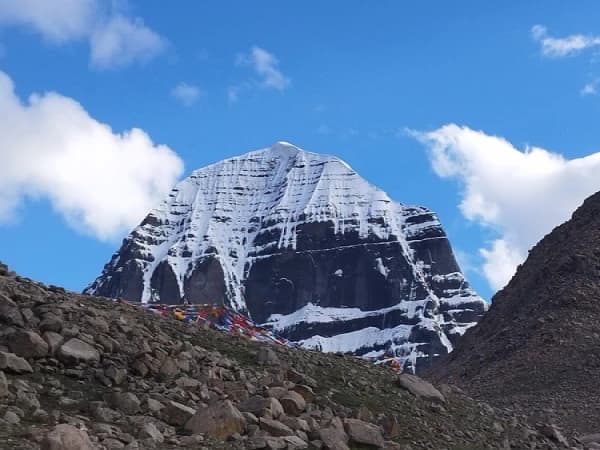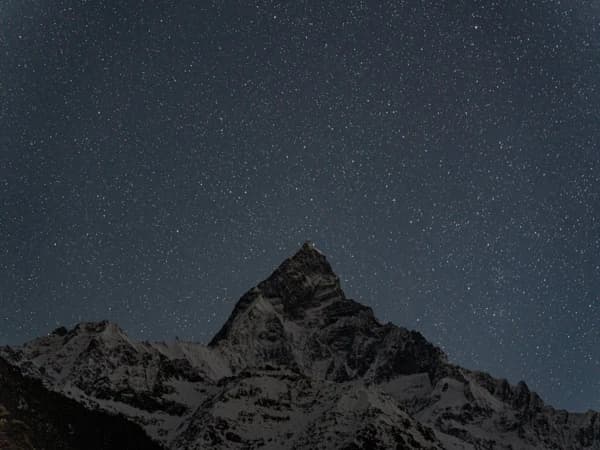Introduction to Annapurna Base Camp Trek
Annapurna Base Camp Trek has always been the most charming trek in the world. This Trek is a true introduction to the serene landscapes and topography of Nepal. The path passes through lush forests of Rhododendrons, Bamboo, and Alpines leading to the awe-inspiring Peaks and Glaciers. This Trek also gives a clear understanding of the lifestyle of Nepalese, specially Gurung and Magar Ethnic Groups and their scenic settlements.

Annapurna Base Camp Trek Route
Trek starts from the tourist city Pokhara. Pokhara is not just famous for its scenic beauty but also extremely popular for many adventurous activities. Similarly, the Trek ends at Nayapul. Nayapul is also the primary starting point for the Trek. The name means 'New Bridge.'
Similarly, there are other ways for Trek as well. Such as starting the Trek from Pokhara to Nayapul or from Kathmandu to Pokhara and then Nayapul.Also, you may include a lot of options in the Trek. The options range from Mardi Himal Trek to Poonhill Trek or Upper Mustang trek to Jomsom Muktinath trek.
Majestic mountains such as Macchapuchre (7000m), Mt. Hiuchuli (6441m), Annapurna South(7219m), Annapurna I(8,091m), and Annapurna III (7555M) looms before the eyes at Annapurna Base Camp and Machhapuchhre Base Camp. When out of the hustle and bustle of cities, one reaches somewhere with a panoramic 360 view of nothing but the virgin mountains. This particular experience remains in the tributaries of the mind forever.
Trip Facts of ABC Trek
Some of the facts about ABC Trek are mentioned below.
Trip Duration 7 Days
Trip Grade Moderate
Best Season Mar-May, Sept-Nov
Maximum Elevation 4,130m
Accommodation Tea House, Lodges
Hiking Per Day 5-7 hours
Starting/Ending Point Nayapul
How to do Annapurna Base Camp Trek?
Your journey to the Annapurna base camp trek starts with a flight to Kathmandu, a drive to Pokhara, where you spend a few days visiting some of the nearby attractions, then it's onto the trail. The Poon Hill trek is often done in combination with the Annapurna Base Camp trek, which starts at Nayapul. Trekkers usually overnight at Ghorepani (2750 m), hiking to Poon Hill (3210 m) for sunrise. The route then continues via Thadapani towards Annapurna Base Camp.
Kathmandu-Nayapul-Ghandruk-chomping-Sinuwa-Dovan-Deurali-MBC-ABC-MBC-Deurali-Dovan-Chomorong-Jhinu-Nayapul-Kathmandu
Itinerary of Annapurna Base Camp Trek
Our Annapurna Base Camp Trek itinerary is 14 days long, and covers most of the sights in the Annapurna region and beyond. This comprehensive itinerary will ensure that you don't miss a thing on your trip to this beautiful part of the world.
Day 1: Arrival at Tribhuwan International Airport, Kathmandu Namaste! Regulus Nepal welcomes you to Nepal!
Day 2: Kathmandu to Pokhara (910m/2985ft) Duration: 6-7 Hours (by Tourist Bus -A/C)
Day 3: Pokhara to Tikhe Dhunga (1495m/4905ft) Distance: 9 km, Walking Duration: 4 Hours
Day 4: Tikhe Dhunga to Ghorepani (2850m/9348ft) Distance: 13 km, Walking Duration: 7 Hours
Day 5: Hike to Poonhill then trek to Tadapani (2500m/8200ft) Distance: 9 km, Walking Duration: 6-7 Hours
Day 6: Tadapani to Chhomrong village (2020m/6625ft) Distance: 8.5 km, Walking Duration: 5 Hours
Day 7: Chhomrong to Dovan (2600m/8528ft) Distance: 9 km, Walking Duration: 5 Hours
Day 8: Dovan to Deurali (3200m/10500ft) Distance: 7.8 km, Walking Duration: 4 Hours
Day 9: Deurali to Annapurna Base Camp via Machhapuchhare Base Camp (4230 M/13810FT) Distance: 8 km, Walking Duration: 5-6 hours
Day 10: Return from Annapurna Base Camp to Bamboo (2310M/7575FT) Distance: 18 km, Walking Duration: 7 Hours
Day 11: Return from Bamboo to Jhinu Danda Hot Spring (1780M/5840FT) Distance: 12 Kms, Walking Duration: 6 Hours
Day 12: Return from Jhinu Danda to Pokhara
Day 13: Return from Pokhara to Kathmandu
Day 14: Farewell/ Trek Ends
Annapurna Base Camp Trek Cost
The cost of the Annapurna Base Camp Trek depends on the level of comfort you want. The prices can start as low as "$25 USD per night, per person for a very basic and low-end trek" and it can go up to $130 USD per night, per person for an "ultra-luxury trek (with a helicopter on a peak)." But the price you pay should not just be based on the number of days you will walk while on this trek. You should rather consider the "price per mile" you are paying because the longer your journey, the higher the price. This is just a blunt estimate, you can browse our Annapurna region page & pick the itinerary that suits you; the rest is up to us; we'll send you the quote as appropriate. This is a smart approach to get the cost of the Annapurna Base Camp trek. Also, you can also make whatever changes you like. The cost of an Annapurna Base Camp trek offered by a local travel agency ranges from USD 700 to USD 1800.
Trekking Map of 14 Days Annapurna Base Camp Nepal
 Highlights of Annapurna Base Camp Trek
Highlights of Annapurna Base Camp Trek
- To witness the highest and most beautiful mountains of the Annapurna range, above 7000m, have to be the major highlight.
- Next, the famous Gurung village 'Ghandruk' is extremely scenic from the peaks of Mt.Machhapuchhre, Mt.Annapurna, Mt.Gangapurna, and Mt.Hiunchuli are visible.
- Besides, the natural hot springs on the way ease away all the body tensions.
- The friendly locals are always there with their warm, hospitable gestures.
- Most of the rare flora and fauna are found only in this region.
- Scenic view from Annapurna Base Camp (4130m)
- Terrace farmlands and Lush Rhododendron forests
Annapurna Base Camp Trek Difficulty
Annapurna Base Camp trek is appraised as a moderate to demanding Trek since the route is very adventurous, having to climb several rocks, and the walking pace is slow and steady. From Kathmandu, which lies at an elevation of 1,400m, to Annapurna Base Camp, with 4,130m, the trekkers need to walk past several villages, Glacier rivers, waterfalls, and sheer cliffs and ridges.
Altitude Sickness is very common while trekking to mountains because the oxygen level decreases as the altitude rises. Therefore, acclimatization is necessary to make sure that minor symptoms may not result in severe ones. Similarly, there are chances of avalanches that may block the trekking routes. In that case, one must always be prepared and follow the instructions of the guide.
Best Season to Trek Annapurna Base Camp Trek
Nepal is such a country where the climate is favorable throughout the year without very vast fluctuations. However, mountains are always unpredictable. Therefore, one should be well informed about suitable climatic conditions.
During April-May, there is the Spring season in Nepal. The weather is very favorable to hiking, making afternoons comparatively hot than the mornings. Thus, April-May is considered the best season to Hike. Second, comes October, November, and December. These seasons are taken as the best season for the clearest skies. Besides Pre-Monsoon and Post-Monsoon is the best month to view stunning snow-covered Mountains.
Annapurna Base Camp Trek FAQs

What are the types of Accommodation you could choose?
There are mainly three types of accommodations available: Camping Accommodation, TeaHouse Accommodation, and Hotel/Lodges Accommodation. Firstly, camping accommodation is usually for trekkers or climbers who want to climb Mt.Annapurna. It's usually done in remote areas, and all the necessary cooking pieces of equipment are carried by themselves. However, such Accommodation is very less common because of the availability of many lodges and teahouses. Secondly, Teahouse accommodation lets you enjoy the beautiful picturesque villages alongside local culture and traditions.
These accommodations are located in the most beautiful settings, and they are integrated with hot solar panels that make the water warm in a cold climate. Lastly, hotels/lodges range from basic to star-rated, which exactly suits your budget. These hotels are well equipped with wifi, comfortable rooms, and pillows, including many other amenities.
What sort of Meals will you be offered during Trek?

Annapurna Conservation Area is managed by the National Trust for Nature Conservation(NTNC), which monitors meals' price ranges. During the Trek, you will be offered Breakfast which mostly includes:
- Tea, Coffee, Juice
- Eggs
- Sausages
- Toasts
- Hashbrown Potatoes
Similarly, Lunch and Dinner include:
- Traditional Nepali 'Daal-Bhat'
- Momos
- Pasta,Noodles, Spaghetti
- Pizza, Sandwich
- Desserts
What are the Festivals you could celebrate?
Annapurna Conservation area houses many groups. They speak different languages within the region. Tamu Lhosar is the major festival of people from the Gurung community, which falls on every push 15th of the Nepali calendar, i.e., December/January. If you happen to Trek during this season, you will see Gurung people in their best attire. Moreover, Magar people celebrate Bhumi Puja on Ashad 1st, i.e., June/July, where adults and children sing and dance.
Also, they use various musical instruments and make merry all night. Out of all these ethnicities, such as Gurung, Magar, Thakali, Manage, and Loba, Gurung happens to be the major group. Gurungs are usually Buddhists, with only a certain percentage of Hindus. Therefore, all the major festivals of Grurungs are celebrated by them.
What type of Flora and Fauna can you witness?
Home to 22 different types of forests, the Annapurna Conservation area houses subtropical sal forests to perennial snow. Similarly,55 species of plants are endemic. Endemic is only found in Nepal.
Annapurna Conservation Area houses about 101 species of mammals that range from rare to endangered. The fauna consists of Snow Leopard, Musk Deer, Tibetan Wolves, Tigers, Elephants, Buffaloes, and various deer species. Likewise, flora includes birch, silver fir, Larch, and Hemlock.
Required Trekking Permits for ABC Trek
The Government of Nepal has made it compulsory for every trekker to have permits before trekking.
Annapurna Conservation Area Permit (ACAP) and Trekker's Information Management System (TIMS) card is mandatory while trekking the Annapurna route; without the permits, one is not liable to Trek.
Gears and Basic Equipment For ABC Trek:

Alongside Courage, Annapurna Trek also requires some solid gear. These gears include:
- Hiking Boots
- Trekking Stick
- Jackets
- Sleeping Bags
- Water Bottle
- Socks
- Trousers and so on.
- Also, bring your equipment such as:
- Power Banks
- Batteries
- Charger etc.
One should always remember that Mountainous areas may lack certain or many facilities from the city area, and thus, one should compromise in such situations. Moreover, one should obtain relevant and precise information from a trustable website like ContentFactoryNepal.
Major Attractions of Annapurna Base Camp Trek
Mount Annapurna
One of the main attractions of the Annapurna Base Camp trek is the opportunity to see Mount Annapurna, the tenth-highest mountain in the world, up close. Standing at an impressive 8,091 meters (26,545 feet) tall, Mount Annapurna is an awe-inspiring sight to behold. As you trek to the base camp, you will be treated to close-up views of this majestic mountain and its surrounding peaks.
The trek to the Annapurna Base Camp can be challenging, with a number of uphill and downhill hikes through rugged terrain. However, the stunning views of Mount Annapurna and the other peaks in the Annapurna range make it all worth it. The close-up views of these majestic mountains will take your breath away and make the challenges of the trek fade into the background. The Annapurna Base Camp trek is a must-do for anyone visiting the Annapurna region, and it offers a unique blend of natural beauty, adventure, and cultural experiences.
Annapurna Base Camp
Annapurna Base Camp is a popular trekking destination and a major attraction in the Annapurna region of Nepal. Located at an altitude of 4,130 meters (13,550 feet), the base camp offers stunning views of the Annapurna mountain range, including Annapurna I (8,091 meters) and its sister peaks Annapurna South, Annapurna Fang, and Annapurna III. You will also have the opportunity to see other iconic peaks, such as Himchuli, Gangapurna, Khangsar Kang, and Machhapuchhre (also known as Fishtail peak).
The most popular route to the Annapurna Base Camp is through Machhapuchhre Base Camp, and it typically takes 2-3 hours to walk from there to the base camp. The trek to Annapurna Base Camp offers a chance to enjoy the natural beauty of the surrounding mountains and experience the fresh, high-altitude environment. Watching the sunrise over the Annapurna mountain range from the base camp is a particularly memorable experience. The Annapurna Base Camp trek is a must-do for anyone visiting the Annapurna region, and it offers a unique blend of natural beauty, adventure, and cultural experiences.
Machhapuchre Base Camp
Machhapuchre Base Camp is a destination on the Annapurna Base Camp trek in Nepal. It is located at the base of Machhapuchre peak, which is also known as Fishtail peak due to its unique shape. The base camp is located at an altitude of 3,700 meters (12,139 feet) and offers stunning views of the surrounding mountains, including the Annapurna South, Hiunchuli, Gangapurna, and Machhapuchre peaks.
The trek to Machhapuchre Base Camp is a physically demanding hike that involves steep ascents and descents through dense forests and across high ridges. Along the way, you will pass through traditional villages and have the opportunity to experience the culture and way of life of the local people. The trek to Machhapuchre Base Camp is a rewarding and memorable experience that offers a unique blend of natural beauty, culture, and adventure.
Jhinu Dada
Jhinu Dada is a village located in the Annapurna region of Nepal. It is a popular destination on the Annapurna Base Camp trek, as it is known for its natural hot springs, which are believed to have therapeutic properties. The hot springs are located about a 45-minute walk from the village, and many trekkers visit them to relax after a long day of hiking.
In addition to the hot springs, Jhinu Dada is a beautiful and peaceful village located in a picturesque setting. You can enjoy the stunning views of the surrounding mountains and experience the local culture and traditions of the Gurung people. Jhinu Dada is a unique and memorable destination on the Annapurna Base Camp trek.
Ghorepani
Ghorepani is a village located in the Annapurna region of Nepal and is a major attraction on the Annapurna Base Camp trek. It is a gateway to the Annapurna region and a popular rest stop for trekkers. The village is home to the Gurung and Magar communities and offers beautiful views of the snow-capped mountains.
During your stay in Ghorepani, you can experience the local culture and traditions, such as cultural programs and the remote lifestyle of the villagers. You can also visit the Hindu temple in the village and learn about the local religion. The next morning, you can hike to Poon Hill to enjoy a beautiful sunrise view over the mountains. Ghorepani is a beautiful and culturally rich village that offers a unique and enjoyable experience on the Annapurna Base Camp trek.
Stunning Mountain Views
The Annapurna Base Camp trek offers breathtaking views of the Annapurna mountain range, including the Annapurna South, Hiunchuli, Gangapurna, and Machhapuchhre peaks.
Lush, Green Landscape
The Annapurna region is known for its lush, green landscape, with terraced rice fields, forests, and streams. The trek takes you through picturesque villages and forests, offering a chance to experience the natural beauty of Nepal
Poon Hill
On the way to the Annapurna Base Camp, you will pass through Poon Hill, a popular destination known for its stunning views of the Himalayan mountain ranges. Poon Hill is a popular viewpoint for enjoying the sunrise and sunset, and it offers breathtaking views of the surrounding mountains, including Dhaulagiri (8,167 meters), Manaslu (8,163 meters), and the entire Annapurna range.
Located at an altitude of 3,210 meters, Poon Hill is a popular destination for trekkers and offers a beautiful and enjoyable experience. If you want to fully experience Poon Hill and the surrounding area, you can opt for a Ghorepani Poon Hill Trekking package, which will take you through this beautiful region and provide you with all the necessary facilities and support. For a better experience, you can opt for 5 days Ghorepani Poon Hill Trek.
Annapurna Conservation Area
The Annapurna Conservation Area is a protected area in the Annapurna region of the Himalayas in Nepal. It is the largest protected area in Nepal and covers an area of 7,629 square kilometers. The conservation area ranges in altitude from 729 meters to the peaks of Mount Annapurna at 8,091 meters. It extends across the districts of Lamjung, Kaski, Manang, Mustang, and Myagadi.
The Annapurna Conservation Area is home to a variety of wildlife, including rare and endangered species such as the snow leopard, musk deer, Himalayan Thar, blue sheep, and others. The chance to see these animals in their natural habitat can make the Annapurna Base Camp trek even more exciting and rewarding.
The Annapurna Base Camp trek is a classic and off-beaten path trek in Nepal that takes you to the base camp of the 10th highest mountain in the world within a period of 15 days. Proper preparation and choosing the best season can make the trek more comfortable and enjoyable. By following the tips and information provided above, you can have a successful and memorable Annapurna Base Camp trek. If you have any further questions about the trek, you can contact the trekking agency at regulusnepal@gmail.com.
Conclusion
Annapurna Base Camp Trek happens to be one of the most classic trekking routes of all time and plays a significant role in Nepal's Tourism Industry. If the trekking is done in favorable conditions and seasons, then one can reap its maximum benefits. In contrast, without proper planning and in case of unfavorable weather, there are chances of heavy avalanches.

Likewise, trekking alone is also allowed but alongside a guide is highly recommended. The trekking agency provides all the necessary documents alongside the required kits. Besides, for anything extra, a trekker should purchase it himself.
Traveling is not only for relaxation, but it is a quest to find oneself and know oneself better. The hustle and bustle lifestyle of the city, Annapurna Mountain Ranges awaits you patiently. Mountains are calling. When will you respond?












